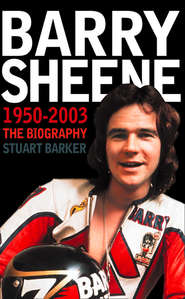По всем вопросам обращайтесь на: info@litportal.ru
(©) 2003-2024.
✖
Niall Mackenzie: The Autobiography
Настройки чтения
Размер шрифта
Высота строк
Поля
I was hoping for a top ten place in the dry but race day was wet so I didn’t know what to expect. I just went into the race with an open mind and tried my best to keep the bike upright and get a decent result. As it turned out, I got seventh place which was the result I wanted but I did ride quite conservatively to make sure I brought the bike home so I feel if I’d pushed it I could probably have done even better.
I got a few pats on the back for my efforts and I was pretty pleased with myself too as it was a good start to my 500 career. Incidentally, I finished tenth in the 250 race so it was quite a productive day for me all in all.
After Silverstone, my confidence was up and I qualified in fourth place on the 250 in the Swedish Grand Prix after being fastest in the second session. It was my best qualifying performance to date by far but I had other things to think about too as I had been given another chance on the 500 Suzuki. Full time rider Paul Lewis had crashed on the first corner at the British GP forcing the race to be re-started. He’d broken some bones in his foot and had to sit out the Swedish race so I now had two full bikes at my disposal. I was actually as high as third place in one qualifying session and finished seventh in the race, one place ahead of my hero, Randy Mamola, which felt pretty awesome.
The last round of the world championships (there was actually one more round for the 80cc, 125cc and Sidecar classes) was held at Misano in Italy and again I was riding both the 250 Armstrong and the 500 Skoal Bandit Suzuki. I went pretty well in practice on the Suzuki and in the first session, I was considerably quicker than Suzuki’s other new rider and future world champion, Kevin Schwantz. In fact my time was good enough to set provisional pole position but I eventually ended up third on the grid behind Eddie Lawson, who had just been crowned 1986 world champion, and his arch rival Wayne Gardner.
I was disappointed at just finishing eighth in the race but my tyres shredded pretty early on, which meant I couldn’t do the times I had done in practice. The 250 race was even worse as I only lasted one lap before the bike seized and I had to retire.
My tyre problems in the 500 race were indicative of a difference in riding style between people like Mamola and Gardner and myself. I never really learned how to ride a 500 like the Americans, backing it into turns and sliding it out sideways on the exit of the corner and in an era of vicious power delivery and relatively poor tyres that’s what it took to win races. There’s no question in my mind that the reason I failed to win a GP was because of my European, high corner speed, 250cc riding style. The American and Australian riders just had an edge over me with their dirt track style. That’s all changed in recent years with the advent of a smoother power delivery and breakthroughs in tyre technology and that’s why Europeans have started winning GPs again.
Back in the ‘80s, I’d be finishing on the rostrum one weekend and then I’d be sixth or seventh the following week and I couldn’t understand why. I felt I was riding just as hard but some weeks I was just getting left behind. I realise now that it was because the Americans and Aussies could adjust their style as the tyres went off. For me, less grip meant I had to slow down but for those guys it just meant they had to spin the tyres up harder and slide the bikes round the corners. That’s what won them races – their adaptability.
All I knew was how to ride the front really hard like Max Biaggi does today. That’s why he has so many front-end crashes and that’s why I had so many too. It’s no coincidence that he’s another ex-250 rider (a four times 250 world champ in fact) and he seemed to have the same problems I had in that he didn’t seem to be able to change his style to suit the 500. Valentino Rossi, on the other hand, also raced 250s but he worked hard and realised he needed to adapt to the 500 and he raced it like it needed to be ridden.
Anyway, 1986 was a busy year for me riding in the 250 and 350cc British championships, the 250GPs and the occasional 500GP as well as in various other domestic races. However I would have raced every day of the week back then as I just loved racing and I certainly never felt like I had taken on too much.
The year ended on a tragic note when my friend Neil Robinson was killed at Oliver’s Mount circuit in Scarborough. It’s a very dangerous, narrow and bumpy track that is lined with trees and isn’t really fit for racing on. Neil was killed in September in a round of the British championship that should never have been held there and it was a great loss to racing. Our careers had run almost in parallel as he used to club race at Knockhill at the same time as me and he also did some Pro-Am races. He then went on to become British 250cc champion in 1983 as I did later on and he even rode for Skoal Bandit Suzuki in the Formula One World Championship while I rode for the same team in 500GPs. ‘Smutty’ was only twenty-four when he died and it was another shocking reminder for me of how dangerous bike racing can be.
Every racing death is a shock but I had this kind of safety valve system that must have developed subconsciously. When I was first told of a death I’d think ‘Shit, no, no, no’ just like everyone else but then after about five minutes I wouldn’t think about it again. It’s not that I didn’t accept that it had happened but I refused to let it bother me, or at least tried to. That sounds very cold and I don’t mean it to be but every racer has to have a way of dealing with the dangers of the sport and their own mortality. If a really close friend or team-mate had been killed I might have stopped racing but it’s hard to say now what I would have done. Who can tell? Ron Haslam lost two brothers racing but he carried on and Robert Dunlop still raced after his brother Joey was killed. It’s strange and sounds heartless, perhaps even selfish to others but it’s just a defence mechanism. After all, you don’t stop driving a car when you hear that someone’s been killed in a car crash, do you?
I didn’t make a habit of going to funerals either and that’s not out of disrespect, it’s just all part of the same defence mechanism that allowed me to shut the dangers of what I did out of my mind as much as possible.
Most of the time you believe you’re in control when you’re racing but then when you have a crash you realise that you’ve just been fooling yourself and that a serious accident could happen to anyone at any time. Many times I sat on the grid after the warm up lap and wondered if I would make it back alive, but as soon as I started the race, all my attention was focused on just going as fast as I could.
I don’t know if bike racers should be considered brave or stupid but there are certainly some riders who are braver than others are, or more stupid than others, but I think the two go hand in hand really. Speaking for myself, I consider that I was as safe as I could have been given the nature of my profession. Many people outside racing think it’s just the guy with the biggest balls that wins but it’s really not like that. The thing is that everyone starts racing when they’re young and daft and it’s just a laugh. You don’t have as much fear then but by the time you do start to have some fear you’ve also got some experience and a feel for when things are likely to go wrong. It may look like you’re still mad but you’re actually in control. Honda’s technical guru Erv Kanemoto, who became my team boss in 1987, once said to me that as a rider gets older he starts to weigh up the percentages and that’s when it’s all over. When you’re twenty, you might do something really risky to win a race that you wouldn’t be prepared to do as a thirty year old – at that age you’d be more likely to back off and accept second place.
You could almost draw a chart with a line for bravery/stupidity and a line for experience and where those two meet a rider should be at his peak. Before that point the rider’s too gung-ho and after it he becomes too cautious. That’s the best way I can explain it and if you understand all that I’ll be impressed! It’s not an easy thing to explain.
My performances on the 500 Suzuki had been good enough to attract a lot of attention and for the 1987 season I had lots of offers on the table. Armstrong offered me a ride again but I wasn’t going to be caught out as I had been the year before by signing a contract before I’d even spoken to other teams so I declined to sign there and then. They had been really good about letting me ride for Suzuki in three GPs so I was very grateful to the team for all they had done for me.
Suzuki offered me a contract worth £50,000 after the Swedish Grand Prix to ride their new V4 and that was a lot of money compared to what I had been on so I signed a letter of intent to ride for them. But I was still open to other offers if anything better came along. I tested the Cagiva just after the final GP in Misano and the firm seemed impressed that I was as quick as Kenny Roberts Senior had been when he tested it.
Anyway, my times were good enough for me to be offered a ride on the Cagiva as well but I still wanted the Suzuki more than the relatively underdeveloped Italian bike, which handled nicely, but the engine just wasn’t strong enough so I didn’t commit. We never really got round to discussing money and I suppose if they had offered me a mental sum of cash I might have been tempted but things never got that far. At that time I had no idea of how much I should be paid – all I knew was what Suzuki had offered and that sounded pretty good to me!
Вы ознакомились с фрагментом книги.
Приобретайте полный текст книги у нашего партнера:
Приобретайте полный текст книги у нашего партнера:







